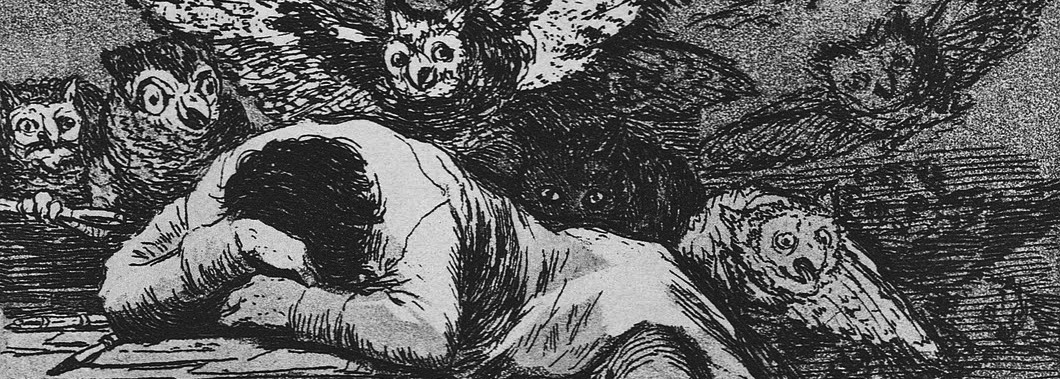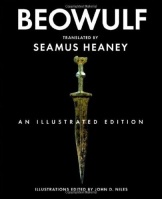Beyond the fact that they make for a rather more attractive package, the many illustrations in the Norton edition of Seamus Heaney's
Beowulf translation rightly turn our attention to the poem's obsession with
things, with physical objects.
On every other page, facing the text itself, are bowls, ships, goblets, shields, arrows, helmets, jewelry, chainmail and the like, all lovingly photographed for our visual pleasure. The pictures neatly reflect and resonate with the poem's own concern with objects that are sometimes so distinctive that they even earn a name for themselves--such as Hrunting, the weapon lent to Beowulf before his fateful encounter with the monster Grendel's frightful mother. Hrunting is described as "a rare and ancient sword," an "iron blade" whose "ill-boding patterns had been tempered in blood" (1458, 1459-60). It fits well with the warrior's "mighty, hand-forged, fine-webbed mail" and his "glittering helmet [. . .] of beaten gold, / princely headgear hooped and hasped / by a weapon-smith who had worked wonders" (1444, 1448, and 1150-52).
In the gift-exchange economy of Dark Ages Europe, heroic deeds and political alliances lead to the accumulation of still more stuff. Once Beowulf has slain the monster and his mother, a grateful King Hrothgar promises that "for as long as I rule this far-flung land / treasures will change hands and each side will treat / the other with gifts" (1859-61). And good as his word, he showers the young prince and his men with artifacts of the highest quality so that by the time Beowulf heads for home he is "glorious in his gold regalia" and their ship is "cargoed with treasure, horses and war-gear" (1881, 1897).
Beowulf has already himself presented Hrothgar with a thing of considerable value: not merely the service he rendered in ridding the land of its demons, but also the hilt from a sword that he had grabbed during the melée in the mother's watery refuge. If anything this "relic of old times" is even more impressive and fascinating than Hrunting, with its "rare smithwork" and its "rune-marking correctly incised" and its engravings in gold that tell the story of "how war first came into the world / and the flood destroyed the tribe of giants" (1688, 1679, 1695, 1689-90). This is an object that can be read to reveal something of days long gone by. The weapon's adornment is more than mere decoration or ostentatious display; it recounts the history that makes the weapon necessary in the first place.
Likewise the hoard guarded by the dragon in the later sections of the poem also comes from an epoch long before the time when the action the narrative describes takes place. It is buried by the last survivor of a once-great civilization who realizes that, with the community that gives it meaning gone, "his joy / in the treasure would be brief" (2240-41). Interring "all the goods and golden ware / worth preserving" this last survivor consigns them to the earth, from which the raw material had originally been taken: "It was mined from you first / [. . .] I am left with nobody / to bear a sword or burnish plated goblets, / put a sheen on the cup" (2248, 2252-54).
In pre-capitalist societies, treasure is not fully fungible. It doesn't circulate with ease--only as the result of either heroic action or as pillage of war. When the community founders, the meaning it confers wavers and is soon lost. Indeed, when Beowulf in turn dies, he has nobody to whom he can bequeath his armour. With his funeral, his treasure will be consumed as "his royal pyre / will melt no small amount of gold: / heaped there in a hoard" (3010-12).
All that is left is the rather more precarious medium of speech and song, the lament of the woman mourner who cries out in "a wild litany of nightmare and lament" (3152-53). And of course the poem, Beowulf: passed down orally for a couple of centuries before it is transcribed somewhere around 1000AD, whose one manuscript copy is almost itself consumed by fire in 1731, and which now survives, a precious object in its own right, in the British Museum. As the Museum website explains, "the manuscript remains incredibly fragile, and can be handled only with the utmost care."
Fortunately, mass production and the publishing industry ensure that the text and this beautiful book now circulate freely, if at a fairly hefty price. A New York Times bestseller and sumptuously illustrated edition, this is a coffee-table book of distinction. No doubt more displayed and admired than read, it shows that cultural capital and presumed status still adhere to and are conveyed by objects as stubbornly today as in feudal Britain.


